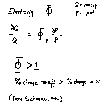Associate Professor of Geological and Atmospheric Sciences
Iowa State University
US Geological Survey realtime data for South Skunk river
Groundwater-"Nuts and Bolts"
Definitions:
Ground water: Subsurface water that occurs beneath a water table in soil and geological units that are fully saturated.
Hydrogeology: ".....interdisciplinary science of the study of water and its interrelation with rocks, soil, and humans, with an emphasis on groundwater" (Stephenson et al., 1991)
Course dealing with groundwater af lSU:
Geology 510, 511, 522, 534
CCE 573, 575, 579
Agronomy 577, 578, 677
ABE 520, 522
 Withdrawal of freshwater in the US
Withdrawal of freshwater in the US
 Per capita freshwater usage in the US
Per capita freshwater usage in the US
Predicted Effects of Climate Change from Water in the 21st Century in Water in Crisis
by Gleick, 1993).
- Change in precipitation and temperature
- Change in storm magnitude and frequency
- Change in snowmelt and snowfall
- Change in runoff
- Change in soil moisture
- Managing water under certainty
Water in the 21st Century (article by Peter Gleick, 1993, in Water in Crisis ).
- Precipitation and temperature:
- Storm frequency and intensity:
- Snowfall and snowmelt:
- Runoff:
- Soil Moisture:
- Groundwater Recharge
1. Addition of mass to the water table by vertical infiltration through the unsaturated (vadose) zone or lateral inflow 2. Recharge to groundwater is some percentage of mean annual precipitation:-
Midwest: 10 to 20%
Arid areas: 0.25 cm/yr
4. Water in many aquifers has been recharged under wetter paleoclimates Hydrograph of water table fluctuations
Hydrograph of water table fluctuations Areas with decreasing groundwater levels
Areas with decreasing groundwater levels - Mining Groundwater
Definition: Overdraft occurs when water removal rates exceed the natural recharge rate- There are many areas of the U.S. where groundwater levels have dropped more than forty feet since predevelopement
- Natural analog for global climate change; i.e. CO2 doubling
- Raising the temperature or ET and/or decreasing precipitation leads to a decrease in the
natural recharge rate and an increased need form pumpage.
1. Doubling of CO2 will result in 3 degree Celsius temperature rise and 3 to 15% precipitation increase.
2. Alters distribution of:
- natural ecosystems
crops
human settlement
water use for human development
1.More frequent extreme events
2. Alters variability of the hydrological cycle
1. Snowpack is a large reservoir that redistributes runoff
2. Temperature increase will:
-
increase ratio of rain to snow in cold months
decrease length of snow season
increase rate and intensity of snow melts
- average winter runoff and peak runoff increase
peak runoff occurs earlier
faster and more complete depletion of soil moisture
increased flooding in mid to upper latitude river basins
1. Water supply
2. Energy generation
3. Human health
4. Commercial/industrial development
5. Critical in areas where demand for water is near the limit of reliable supply
 Percent change in mean annual runoff
Percent change in mean annual runoff
1.Determines what plants can grow in different regions and how much additional
water should be applied for irrigation
2. Generally overlooked in climate impact studies because
it is difficult to model directly and is the leftover from precipitation and evapotranspiration (ET)
(coupling GCM's to land surface)
3. Increase in precipitation not equal to greater soil moisture (increase in ET may exceed increase in
in precipitation and cause drying)
4. Thus, droughts may increase as temperature rises despite the increase in precipitation. because
ET also rises
5. Soil moisture in mid-latitude continents will decrease due to higher temperatures.
combined with insufficient precipitation, increases - based on 5 different climate models
6. What about groundwater recharge?
- A major source of water for the High Plains (from Texas to South Dakota)
- Course-grained stream sediments shed from mountains in the west
- Since the 1900's use has increased due to :
- the 1930's drought
- the 1950's drought
- cheap energy
- high food prices
- a switch by farmers from growing cotton in the south to growing irrigated crops used for beef production
- the 1930's drought
- In 1990, 15.6 million acre feet of water was removed from the Ogallala aquifer to irrigate 14 million acres of land
- In 1978, 170,000 wells were pumping 3X10^10 cubic meters of water per year
- These exceed the natural recharge rate by to 2 to 1000 times (the natural recharge rate is less than 0.5 cm per year on the Southern High Plains)
- The most critical saturated thickness occurs in Texas
 Principle geologic units of the High Plains aquifer
Principle geologic units of the High Plains aquifer
 Water-level changes in the High Plains aquifer
Water-level changes in the High Plains aquifer
Water-Level Changes in the High Plains Aquifer, Predevelopment to 1994
- Great uncertainty about management and supply of fresh water resources
- Hydrologic processes are stochastic- we estimate the probability of future events, i.e., imply stationary climate
- Climate is not stationary, therefore the probability of future events are difficult to predict
- Governments unwilling to share water information or management schemes
 Ames map showing locations of hydrogeologic interest
Ames map showing locations of hydrogeologic interest



